Interior Finishing
Plaster
Plaster is a traditional method for providing a very durable finish that offers design flexibility in the finished appearance. There are two basic types of plaster, and they vary by base material. Plaster can be Portland cement or gypsum based in its composition. Portland cement plaster is commonly called stucco, and because of its resistance to degradation in the presence of water it is primarily used in exterior environments or in interior wet areas such as gang showers.
Since gypsum will degrade after continued exposure to water it is used exclusively on the interior of a building. This discussion on plaster will focus on gypsum plaster. There are two types of gypsum plaster that are in use today. The first type is conventional plaster, and has been used successfully for many years. It is a three-coat process where the plaster is applied over the substrate in three successive applications. The plaster used in the first two coats is called a basecoat plaster. The third and final coat is called a finish plaster. The second type of plaster is a special adaptation of conventional and is called veneer plaster. Veneer plaster has the option of being applied in a two coat plaster (basecoat and finish) or in a finish only. Both types are considered a “wet” application for they arrive on site in powder form where they are mixed and applied to a substrate in a wet state.
Note: The limitations provided here are taken from appropriate building product manufacturer's source. For more and the latest information relative to these limitations, it is recommended to contact either the representative association or a specific building product manufacturer. A partial list of associations, and their links is provided on the home page of this site.
Gypsum Conventional Plaster
Gypsum Basecoat Plaster
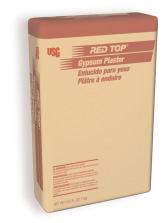 Composition Gypsum plasters requiring the addition of aggregates consisting of either sand, vermiculite, or perlite
Composition Gypsum plasters requiring the addition of aggregates consisting of either sand, vermiculite, or perlite
Size 50 lb. bags
Application Interior walls and ceilings over metal or gypsum lath
Compliance ASTM C28 Standard Specification for Gypsum Plasters
Limitations:
Not recommended for use with perlite aggregate when machine applied, with vertical lift over 30 ft. or when hose length is over 150 ft.
Where sound isolation is the prime consideration, only sand aggregate should be used.
Over interior monolithic concrete, a plaster bonder must be applied before plastering.
Gypsum plasters should not be used where they will come into contact with water or excessive moisture.
Plaster application on masonry or concrete walls, or ceilings that have been coated with bituminous compounds or other waterproofing agents, are not recommended. The interior side of exterior walls should be furred and lathedprior to plastering to prevent seepage and condensation.
Basecoat plasters must not die or stop against a hollow metal door frame return. Dampen trim return vibration by grouting, and by using special anchors. The grout must be raked out to allow lath and plaster to be inserted into the frame.
Installation ASTM C842 Standard Specification for Application of Interior Gypsum Plaster
Architectural Spec 09 21 Plaster and Gypsum Board Assemblies. More and Latest Information Link www.gypsum.org
Gypsum Finish Plaster
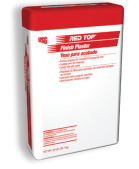 Composition: Gypsum finish plaster with mill-mixed lime only requiring the addition of water
Composition: Gypsum finish plaster with mill-mixed lime only requiring the addition of water
Size: 50 lb. bags
Application: Interior walls and ceilings over gypsum basecoat plaster
Compliance: ASTM C28 Standard Specification for Gypsum Plasters
Limitations:
A smooth trowel finish should not be applied over a lightweight aggregated basecoat plaster over metal lath. Only sand float finish is recommended.
Gypsum lime-based finishes including Keene’s Cement should not be applied over Portland cement basecoat, or over concrete block or other masonry surfaces.
Lime containing finish plasters over conventional basecoat plasters should age 30 days before any surface treatment.
Primers containing polyvinyl acetate (PVA) are not recommended and should not be specified for use over wet plaster of any kind.
Installation: ASTM C842 Standard Specification for Application of Interior Gypsum Plaster
Architectural Spec: 09 21 Plaster and Gypsum Board Assemblies.
More and Latest Information Link: www.gypsum.org
Gypsum Veneer Plaster
Gypsum Basecoat Veneer Plaster
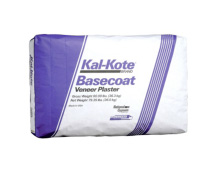 Composition: Gypsum Basecoat Veneer Plaster
Composition: Gypsum Basecoat Veneer Plaster
Size: 80 lb. bags
Application: Interior walls and ceilings over gypsum panel base
Compliance: ASTM C 587 Standard Specification for Gypsum Veneer Plasters
Limitations:
Not recommended for exterior use.
Gypsum plaster should not be used where it will come in contact with water or excessive moisture.
Plaster must be kept dry until used. It must be stored off the ground, under cover and away from moisture sources.
Not to be used in areas subjected to temperatures exceeding 125°F (52°C) for extended periods.
Installation: ASTM C 843 Standard Specification for Application of Gypsum Veneer Plaster
Architectural Spec: 09 26 Veneer Plastering More and Latest Information Link: www.gypsum.org
Gypsum Veneer Plaster:
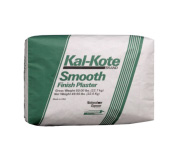 Composition: Gypsum Veneer Plaster
Composition: Gypsum Veneer Plaster
Size: 50 lb. bags
Application: Interior walls and ceilings over gypsum panel base
Compliance: ASTM C 587 Standard Specification for Gypsum Veneer Plasters
Limitations:
Not recommended for exterior use.
Gypsum plaster should not be used where it will come in contact with water or excessive moisture.
Plaster must be kept dry until used. It must be stored off the ground, under cover and away from moisture sources.
Not to be used in areas subjected to temperatures exceeding 125°F (52°C) for extended periods.
Installation: ASTM C 843 Standard Specification for Application of Gypsum Veneer Plaster
Architectural Spec: 09 26 Veneer Plastering
More and Latest Information Link: www.gypsum.org
Drywall Finishing Systems
The most common method of finishing the joints in a drywall application is to treat the joints with a reinforcing joint tape and compound. The joint tape is a strip of material designed to be embedded in compound for this application. Also, any exposed fastener heads are treated with the same compound. The joint compound is available in two basic formulations, drying and chemically setting. The drying type comes in a premixed form and is ready to apply to the joint. Its drying action is what makes the bond to the gypsum panel to create a smooth joint. The chemically setting type comes in a bag and is mixed with water. This material “sets” or “cures” in place similar in concept to concrete. Each formulation offers unique features and benefits.
Ready-Mix Joint Compound
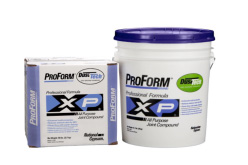 Composition: Vinyl base ready-mix joint compound
Composition: Vinyl base ready-mix joint compound
Size: 61 lb. carton or pail
Application: Finish gypsum panel joints (with reinforcing tape) and fastener heads
Compliance: ASTM C475 Standard Specification for Joint Compound and Joint Tape for Finishing Gypsum Board
Limitations:
Protect from freezing and exposure to extreme heat and direct sunlight, conditions which will cause premature aging of the product.
Do not over thin.
Excessive mixing with an electric drill can cause undesirable changes in viscosity and in finished surface appearance.
Installation: ASTM C 840 Standard Specification for the Installation and Finishing of Gypsum Board
Architectural Spec: 09 21 Plaster and Gypsum Board Assemblies.
More and Latest Information Link: www.gypsum.org
Chemically Setting Joint Compound
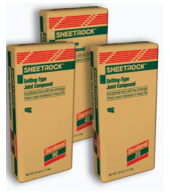 Composition: Chemically setting joint compound job-mixed with water
Composition: Chemically setting joint compound job-mixed with water
Size: 25 lb. bag
Application: Finish gypsum panel joints (with reinforcing tape) and fastener heads
Compliance: ASTM C475 Standard Specification for Joint Compound and Joint Tape for Finishing Gypsum Board
Limitations:
Chemically setting-type joint compounds are more difficult to sand and smooth after drying and should be smoothed before set or while damp, but not completely hardened.
Setting action cannot be delayed or prevented by dilution with water.
Do not apply over moist surfaces or surfaces likely to become moist, or on below-grade surfaces or surfaces projecting outside building structure unless protected from direct exposure to moisture.
Cure new interior concrete surfaces 60 days or more before using chemically setting-type joint compounds.
Remove protrusions, ridges, form or parting oils, grease and efflorescence.
Prior to using any epoxy coating over any surface treated with joint compound, consult the epoxy coating manufacturer and follow manufacturer’s recommendations regarding the preparation or suitability of substrates for the epoxy coating. Many epoxy coatings exert significant shear stress on the substrate as the strong epoxy film shrinks while curing/drying. This stress can cause the bond of the joint compound to fail, resulting in delamination problems.
Installation: ASTM C 840 Standard Specification for the Installation and Finishing of Gypsum Board
Architectural Spec: 09 21 Plaster and Gypsum Board Assemblies.
More and Latest Information Link: www.gypsum.org
Information contained herein is obtained from the following sources:
The Gypsum Association, www.gypsum.org
National Gypsum Company, www.nationalgypsum.com
United States Gypsum Company, www.usg.com
While reasonable effort has been made to ensure the accuracy of this information, we assume no liability for any errors or omissions on these pages. Please verify all information with the organizations mentioned above.
